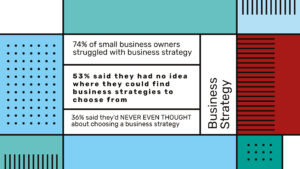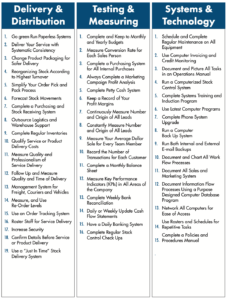Business Strategy – The Art Of Exponential Growth
Do you ever sit and wonder how much difference a business strategy can make?
Do you get confused when sitting down to think about how you can grow the business?
Or do you get stressed as you attempt to generate ideas?
With a mind that’s gone vacant and blank.
The small business research institute recently conducted a survey. They found that over 74% of small business owners struggled with “business strategy”.
And 36% said they’d NEVER EVEN THOUGHT about choosing a business strategy.
They get up, work in the business, and repeat.
Are you in this group of frustrated, stressed-out business owners?
If you are, you may have flushed millions of pounds down the toilet.

Business Strategy
When you don’t choose the right business strategy…
The biggest problem that business owners face is NOT the economy.
Nor is it any other external factor.
The single biggest problem that stops small business owners from growing is…
…working IN the business.
A young woman leaves school and decides that she wants to become a hairdresser.
And doing what she loves.
She goes to college and spends 3 years learning how to cut hair.
Then she gets a job and starts getting clients.
A few more years pass. She’s getting good now. And her clients are growing.
It won’t be long until she has no room in the diary for more clients.
So she decides to go it alone.
She takes the big brave step…
…And opens her own business.
But what’s the VERY FIRST thing that she does (after she’s made her new shop look pretty)?
She spent 3 years learning to cut hair.
Then started a new profession.
She became a BUSINESS OWNER.
And how many years did she spend studying her new profession?
What did she learn about marketing (the most important function in ANY business)?
But the biggest oversight…
…She didn’t learn a single thing about choosing a strong business strategy.
And that’s where most business owners get it wrong.
They know how to be a great “technician”.
But they never take the time to study how to be a great business owner.

Business Strategy And Education
The first and most important business strategy
Before you dive deep into all the different strategies that you could use, here’s the most important one…
Learn.
And not about being a better technician.
Learn how to be a great business owner.
Without business education, your business will suffer.
When you spend the time to learn how to run a great business, something magical will happen…
…you’ll go from feeling stressed out, frustrated, and worried.
To:
- Living a life on your terms
- Making more money than you ever thought possible
- Feeling free with all the options that you’ve got
- Know that you can now grow ANY business
- And get your peace of mind back.
What else do I need to know about choosing the right business strategy?
Once you’ve got a basic understanding of business, it’s much easier to choose a great strategy.
The best place to start is with the “end in mind”. As Stephen Covey mentions in his best-selling book “The 7 Habits of highly effective people“.
If you decide to randomly pick a strategy, it becomes a lottery.
But when you have a clear goal, and choose the strategies that are designed to get you there, it becomes strategic.
Before choosing the right business strategy, it’s important to understand your business goals.
Setting clear business goals helps you to focus on what’s important. Then you can align your strategy with your vision for the future.
When you’re choosing a goal, make sure it’s clear.
You should be clear on how you’ll feel when you complete the goal.
What you’re doing it for.
How you will know once it’s complete.
And what both the short-term and long-term objectives are.
Short-term goals help you to achieve quick wins and build momentum.
Long-term goals help you to achieve your dreams.
Once you have a clear understanding of your business goals, you can use them to choose a strategy.
Your goals will help choose the types of strategies that are best for your business.
They’ll also help you to focus on the areas that are most important for achieving success.
For example, if your goal is to increase revenue…
…you may want to focus on customer acquisition strategies.
Strategies that help you to reach new customers and generate more sales.
But, it will be different if your goal is to improve your operational efficiency. You’ll choose different strategies.
Choosing the Right Business Strategy to Get More Customers
When it comes to growing your business…
…is there anything more important than getting new customers.
Customer acquisition is a key driver of business growth. It can help you to expand your customer base, increase your revenue, and improve your bottom line.
To choose the right business strategy, what do you need to consider?
You might want to think about things like your target audience, your budget, your industry, and your competition.
You’ll also need to think about the strengths and weaknesses of different strategies.
Then choose the ones that are most likely to be effective for your business.
There are 4 main ways to get more customers.
– Increase HOW MUCH each customer spends (known as average sale)
– Increase how OFTEN each customer buys (known as the number of transactions)
There are hundreds of strategies to choose from.
But there are a few things to help you pick the right one.
1. Which strategies align with your goal
2. Choosing the strategies that most suit your business (some won’t be relevant at all)
3. Doing more of what has worked in the past
4. And less of what hasn’t
5. It’s also worth thinking about which strategies you’d ENJOY implementing
6. And the most important thing to consider, is your market research. If you complete market research and do a great job, your customers will TELL YOU what the best strategy is.
You’ll find 290 different strategies, all geared towards making more money.

A list of 290 business strategies to make more money
Choosing the Right Business Strategy to Systemise Your Business
Systemising your business helps with efficiency, productivity, and profitability.
– Streamlining your processes
– And implementing standardised systems.
When you’ve done it well, it will reduce errors, improve consistency, and save both time and resources.
They include the size and complexity of your business.
And the specific processes that you want to systemise.
You’ll also need to choose the strategies that are most likely to be effective for YOUR business.
Here are a few things that you can use to systemise your business.
Process mapping
Identifying and documenting your business processes to improve efficiency and consistency.
Workflow automation
Automating repetitive tasks and processes to reduce errors and save time.
Standard operating procedures (SOPs)
Creating standard procedures and guidelines for your employees to follow. It will improve consistency and reduce errors.
Training and development
Investing in employee training and development to improve skills and knowledge. Then you can ensure that everyone is working towards the same goals with the same skills.
Outsourcing
Outsourcing certain tasks or processes can save time. And make you more efficient.
There are another 50 strategies to choose from when it comes to systemising your business.
They split over three categories.
Delivery And Distribution – Making sure the customer gets the product or service they paid for.
Testing And Measuring.- Which is the most effective way to see if your business is working.
Systems And Technology – Using leverage to speed up and improve.
Choose the strategies that are right for your business, ignore the ones that aren’t. And remember, it only takes ONE great strategy to change a business.

Business Strategy – Systemising Your Business
Choosing the Right Business Strategy to Manage And Lead Your Team
As the owner, you need to give your team clear direction, support, and motivation.
When you do, you can improve productivity.
Which will come when you foster a positive workplace culture.
And the increased productivity and positive culture will help achieve your business goals.
When choosing a business strategy to manage and lead your team, there are a few things to think about.
They are all specific to YOU.
Your business goals (funny how often that comes up!)
Your employees’ needs and preferences
And the strengths and weaknesses of different management strategies.
You’ll also need to think about the different leadership styles.
And how different strategies might affect your management team.
Here are some examples of team management strategies that you can use:
Assigning tasks and responsibilities to employees based on their strengths and skills.
Establishing clear communication channels to ensure that everyone is on the same page.
And working towards the same goals.
Setting clear performance expectations of your team. That includes providing regular feedback and coaching. And rewarding employees for their achievements.
Investing in employee training and development to improve skills and knowledge.
Recognising and rewarding employees for their achievements. You should also praise their contributions to the team and the business.

Choose The Right Strategy To Manage And Lead Your Team
Implementing Which Ever Strategy You Choose
There’s one thing that makes people fail when it comes to implementation…
Being flakey.
One of the more common questions we get asked is “what do the successful people that you work with have in common?”
And there is one thing.
It’s a clear thread.
And all the most successful people that we work with have it in common.
They do what they said they were going to do.
They turn up.
And give 100%.
It’s a sure thing that they’ll be on time.
And they take ACTION.
Those that struggle, are flakey.
They turn up late.
Make excuses.
And can’t stick to one thing.
That’s the next step to take to grow your business.
Once you’ve chosen the right strategy for your specific goals and needs, the next step is to action them.
Here are some important things to keep in mind:
The importance of a solid implementation plan
Before you start implementing your chosen business strategy, you should have a plan.
Taking the time to do a plan means you’ll be far more effective when you take action.
Your plan should outline specific action points.
You can add timelines and responsibilities for everyone involved in the process.
Without a clear implementation plan, you risk wasting valuable time.
You might even waste resources and fail to achieve your desired results.
So take the time to map out a detailed plan that takes into account all the necessary factors.
Clear Communication
One of the keys to successful implementation is effective communication.
Make sure everyone involved in the process understands their role and responsibilities.
You can’t just tell the team to “communicate well”.
Instead, you’ll need a structure.
A system.
And a way of communicating effectively with your team.
Monitoring and measuring the success of your strategy
Finally, it’s important to check and measure the success of the strategy.
It’s the only way that you’ll know whether it’s having the desired impact.
It might involve setting specific targets.
Or having key performance indicators (KPIs) to track progress.
You should review and analyse your progress against the targets on a regular basis. It can help you identify areas where you need to make adjustments and optimise your approach.
Summary
How much difference can a great business strategy make?
All the difference in the world.
Just ask Nike. Their “Air Jordan” strategy led them to an industry-changing deal with Michael Jordan.
And things have never been the same since.
Nike exploded.
And you can too.
If you follow the simple steps to choosing a business strategy that works.
When you get it right, you’ll be:
- Living a life on your terms
- Making more money than you ever thought possible
- Feeling free with all the options that you’ve got
- Know that you can now grow ANY business
- And get your peace of mind back.
So follow the steps above and watch how your business changes.
A great strategy can change a companies destiny.
As long as you take action.
Have there been any strategies that you’ve found to be helpful? If so, let us know in the comments box.












